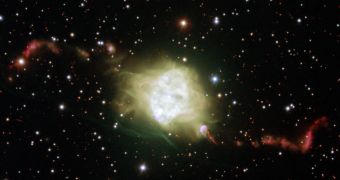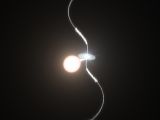Planetary nebulae, despite their name, have nothing to do with planets and have anything to do with dying stars. During the red giant phase, stars grow to several times their initial sizes. It's during this time that the outer layers of gas pushed outwards, while the star eventually shrinks down to a white dwarf.
Normally, this would result in a spherical planetary nebula, but many that have been found in the galaxy come in very strange shapes.
How one particularly strange but beautiful planetary nebula was formed has finally been revealed.
Astronomers using the European Southern Observatory's Very Large Telescope, discovered that the Fleming 1 nebula is the result of two white dwarfs orbiting each other very, very closely.
The two stars take just 1.2 days to circle each other, which is why they weren't identified as two separate stars before. This movement explains the mysterious and gorgeous gas spirals that surround them.
What happens is, as the two orbit each other and transfer material they also shoot out gas outwards. Normally, this would be at a star's poles.
The system's movement though shifts the position of the poles in a circular pattern resulting in spiral jets.
"The pair of stars in the middle of this nebula is vital to explain its observed structure. As the stars aged, they expanded, and for part of this time, one acted as a stellar vampire, sucking material from its companion," ESO explained.
"This material then flowed in towards the vampire, encircling it with a disc known as an accretion disc [6]. As the two stars orbited one another, they both interacted with this disc and caused it to behave like a wobbling spinning top — a type of motion called precession," it said.
"This movement affects the behaviour of any material that has been pushed outwards from the poles of the system, such as outflowing jets," it added.
Astronomers had computer models that predicted the binary nature of the system and the gas formations around the stars that would create the nebula we see.
Using the ESO telescope, they were able to confirm that the accretion disc in binary system is responsible for the peculiar jets.

 14 DAY TRIAL //
14 DAY TRIAL // 
